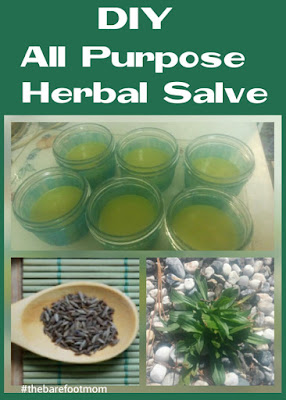In this post I will share my recipe and step by step instructions for my all purpose healing salve.
First though, I need to tell you about an amazing backyard herb I like to harvest for this salve called plantain.
Plantain- A Magical Backyard Weed:
The plantains (there are several varieties) are a medicinal herb that can be found growing just about anywhere. Chances are you have some growing in your yard or near your home. Plantain is anti-inflammatory and has both antimicrobial and analgesic properties. It's soothing to minor wounds and insect bites and can even help stop bleeding. Plantain reduces mucous production, making it a good choice for colds and other respiratory issues. For more information and to learn how to identify this awesome little herb, check out this post from Gwen's Nest.
If you can't find any growing near you or would rather just order some, Mountain Rose Herbs sells dried plantain leaf. You can order some here.
Remove your oil from the heat and let it cool a little for easier handling.
Strain the herbs from the oil by pouring through a cheesecloth or coffee filter. Let it drip as much as it will and even squeeze it a little to get all the oil. Discard the used herbs.
Put the infused oil back into a clean double boiler or a clean mason jar and heat again while slowly adding beeswax. Add beeswax until you get the consistancy you want. Consistancy can be checked by dipping a clean spoon or butter knife into the mixture and then pulling it out and giving it a minute to cool. Your salve should have a consistancy similar to chapstick.
Once the wax is fully melted and you have the consistancy you want, remove from heat and pour into small glass jars, tins, and/or empty chapstick containers.
Once it's cool, your salve is ready to use on bug bites, rashes, bruises, minor scrapes, minor burns, as chest rub for respiratory issues, etc..
If you can't find any growing near you or would rather just order some, Mountain Rose Herbs sells dried plantain leaf. You can order some here.
 |
| Narrow Leaf Plantain |
All Purpose Herbal Salve Recipe:
Ingredients:
-3 cups of olive oil
-About 1/3 cup of beeswax pelletts
-3 tablespoons of dried plantain leaf
-3 tablespoons of dried lavender
-3 tablespoons of dried chamomile (optional)
-2 tablespoons of dried yarrow (optional)
-Several drops of each of the following essential oils: lavender, tea tree, cypress (optional, essential oils add some healing qualities but aren't necessary)
Step one is to infuse the herbs into the oil. To do this, heat the oil and herbs over low heat in a double boiler for several hours. If you don't have a double boiler, you can put the oil and herbs in a large mason jar, loosly set the lid on top, and set in a large pot 3/4 full of water. Heat over low heat on the stove. Your oil is ready when it's very green.
-3 cups of olive oil
-About 1/3 cup of beeswax pelletts
-3 tablespoons of dried plantain leaf
-3 tablespoons of dried lavender
-3 tablespoons of dried chamomile (optional)
-2 tablespoons of dried yarrow (optional)
-Several drops of each of the following essential oils: lavender, tea tree, cypress (optional, essential oils add some healing qualities but aren't necessary)
Step one is to infuse the herbs into the oil. To do this, heat the oil and herbs over low heat in a double boiler for several hours. If you don't have a double boiler, you can put the oil and herbs in a large mason jar, loosly set the lid on top, and set in a large pot 3/4 full of water. Heat over low heat on the stove. Your oil is ready when it's very green.
Remove your oil from the heat and let it cool a little for easier handling.
Strain the herbs from the oil by pouring through a cheesecloth or coffee filter. Let it drip as much as it will and even squeeze it a little to get all the oil. Discard the used herbs.
Put the infused oil back into a clean double boiler or a clean mason jar and heat again while slowly adding beeswax. Add beeswax until you get the consistancy you want. Consistancy can be checked by dipping a clean spoon or butter knife into the mixture and then pulling it out and giving it a minute to cool. Your salve should have a consistancy similar to chapstick.
Once the wax is fully melted and you have the consistancy you want, remove from heat and pour into small glass jars, tins, and/or empty chapstick containers.
Once it's cool, your salve is ready to use on bug bites, rashes, bruises, minor scrapes, minor burns, as chest rub for respiratory issues, etc..
If you enjoyed this post, check out some of my other wellness posts:
Follow me on:



Thank you so much for sharing your recipe and the benefits of this plant. I have just been getting rid of this weed I didn't realise how beneficial it was.
ReplyDeleteI didn't know what it was either until a couple years ago, we always tried to get rid of it too. It's amazing how many common backyard weeds actually have medicinal and/or nutritional value.
DeleteThis is awesome! I'm definitely going to try this!
ReplyDelete